Evaluation of Functionality of Warning System in Smart Protective Clothing for Firefighters
Abstract
1. Introduction
2. Materials and Methods
2.1. Personal Warning Systems for a Use with Smart Protective Clothing for Firefighters
- Signaling modules should be light and implemented in a way that does not adversely affect the ergonomics of protective clothing;
- They should not absorb excessive attention during operation, at the same time their signal should be recognizable;
- The way the signaling modules work should involve the use of hands as little as possible.
- PWS with LCD display;
- PWS with LEDs;
- PWS with vibration element.
2.2. Testing Methodology
2.2.1. Tested Object
2.2.2. Testing Procedure
2.2.3. Apparatus and Tools Used
3. Results and Discussion
3.1. Test Results of the Voice Response Time to the Signal
3.2. Survey Results
4. Conclusions
Author Contributions
Funding
Institutional Review Board Statement
Informed Consent Statement
Data Availability Statement
Conflicts of Interest
References
- Stelios, M.; Mitilineos, S.A.; Chatzistamatis, P.; Vassiliadis, S.; Primentas, A.; Kogias, D.; Michailidis, E.T.; Rangoussi, M.; Bahadir, S.K.; Atalay, Ö. Physiological parameters monitoring of fire-fighters by means of a wearable wireless sensor system. In Proceedings of the IOP Conference Series: Materials Science and Engineering, Mykonos, Greece, 27–30 September 2015; pp. 1–9. [Google Scholar]
- Grant, C.; Jones, A.; Hamins, A.; Bryner, N. Research Roadmap for Smart Fire Fighting, Gaithersburg: National Institute of Standards and Technology. IEEE Potentials 2015, 34, 35–40. [Google Scholar] [CrossRef]
- Gaura, E.I.; Brusey, J.; Kemp, J.; Thake, C.D. Increasing safety of bomb disposal missions: A body sensor network approach. IEEE Trans. Syst. Man Cybern. 2009, 39, 621–636. [Google Scholar] [CrossRef]
- Smith, D.L.; Barr, D.A.; Kales, S.N. Extreme sacrifice: Sudden cardiac death in the US fire service. Extrem. Physiol. Med. 2013, 2, 1–9. [Google Scholar] [CrossRef] [PubMed]
- Wejman, M.; Przybylski, K. Identyfikacja zagrożeń na stanowiskach pracy strażaków zawodowych. Zeszyty Naukowe Politechniki Poznańskiej. Organ. I Zarz. 2013, 59, 69–84. [Google Scholar]
- Bonfiglio, A.; Carbonaro, N.; Chuzel, C.; Curone, D.; Dudnik, G.; Germagnoli, F.; Hatherall, D.; Koller, J.M.; Lanier, T.; Loriga, G.; et al. Managing catastrophic events by wearable mobile systems. In International Workshop on Mobile Information Technology for Emergency Response; Springer: Berlin/Heidelberg, Germany, 2007; volume 4458, pp. 95–105. [Google Scholar]
- Sawicki, T. Czynniki zagrażające bezpieczeństwu strażaków w warunkach pożaru. Bezp. Pracy Nauka Prakt. 2004, 7–8, 35–38. [Google Scholar]
- de Sierra, A.S.; Avila, C.S.; Casanova, J.G.; del Pozo, G.B. A stress-detection system based on physiological signals and fuzzy logic. IEEE Trans. Ind. Electron. 2011, 58, 4857–4865. [Google Scholar] [CrossRef]
- Pham, V.T.; Le, Q.B.; Nguyen, D.A.; Dang, N.D.; Huynh, H.T.; Tran, D.T. Multi-Sensor Data Fusion in A Real-Time Support System for On-Duty Firefighters. Sensors 2019, 19, 4746. [Google Scholar] [CrossRef] [PubMed]
- Jovanov, E.; O’Donnell Lords, A.; Raskovic, D.; Cox, P.G.; Adhami, R.; Andrasik, F. Stress monitoring using a distributed wireless intelligent sensor system. IEEE Eng. Med. Biol. Mag. 2003, 22, 49–55. [Google Scholar] [CrossRef] [PubMed]
- Meina, M.; Ratajczak, E.; Sadowska, M.; Rykaczewski, K.; Dreszer, J.; Bałaj, B.; Biedugnis, S.; Węgrzyński, W.; Krasuski, A. Heart Rate Variability and Accelerometry as Classification Tools for Monitoring Perceived Stress Levels—A Pilot Study on Firefighters. Sensors 2020, 20, 2834. [Google Scholar] [CrossRef] [PubMed]
- Cho, D.; Ham, J.; Oh, J.; Park, J.; Kim, S.; Lee, N.K.; Lee, B. Detection of Stress Levels from Biosignals Measured in Virtual Reality Environments Using a Kernel-Based Learning Machine. Sensors 2017, 17, 2435. [Google Scholar] [CrossRef] [PubMed]
- Tartare, G.; Zeng, X.; Koehl, L. Development of a wearable system for monitoring the firefighter’s physiological state. In Proceedings of the 2018 IEEE Industrial Cyber-Physical Systems (ICPS), St. Petersburg, Russia, 15–18 May 2018; pp. 561–566. [Google Scholar]
- Healey, J.A.; Picard, R.W. Detecting stress during real-world driving tasks using physiological sensors. IEEE Trans. Intell. Transp. Syst. 2005, 6, 156–166. [Google Scholar] [CrossRef]
- Raj, J.V.; Sarath, T.V. An IoT based Real-Time Stress Detection System for Fire-Fighters. In Proceedings of the 2019 International Conference on Intelligent Computing and Control Systems (ICCS), Madurai, India, 15–17 May 2019; pp. 354–360. [Google Scholar]
- Cicioğlu, M.; Çalhan, A. Internet of Things-Based Firefighters for Disaster Case Management. IEEE Sens. J. 2021, 21, 612–619. [Google Scholar] [CrossRef]
- Salim, F.; Prohasky, D.; Belbasis, A.; Houshyar, S.; Fuss, F.K. Design and evaluation of smart wearable undergarment for monitoring physiological extremes in firefighting. In Proceedings of the International Symposium on Wearable Computers, ISWC, Seattle, WA, USA, 13–17 September 2014; pp. 249–254. [Google Scholar]
- Al Hamadi, A.; Al Hamadi, M.; Al Awadi, N.; Moumouni, Y. Multi-Functional Safety Jacket for Firefighters. In Proceedings of the 2019 Advances in Science and Engineering Technology International Conferences (ASET), Dubai, United Arab Emirates, 26 March–10 April 2019; pp. 1–5. [Google Scholar]
- Pietrowski, P. New PPE system development based on integration of sensors, nanomaterials and ICT solutions with protective clothing-I-Protect project approach. In Innovations in Clothing Technology & Measurement Techniques; Bartkowiak, G., Frydrych, I., Pawłowa, M., Eds.; Technical University of Lodz Press: Warsaw, Poland, 2012; pp. 163–170. [Google Scholar]
- Berling, L. Smart Textiles and Wearable Technology-A Study of Smart Textiles in Fashion and Clothing; Swedish School of Textiles, University of Boras: Boras, Sweden, 2013. [Google Scholar]
- Voirin, G. Working garment integrating sensor applications developed within the PROeTEX project for firefighters. In Ubiquitous Computing in the Workplace. What Ethical Issues? An Interdisciplinary Perspective; Kinder-Kurlanda, K., Niham, C.E., Eds.; Springer: Cham, The Netherlands, 2015; pp. 25–36. [Google Scholar]
- Hertleer, C.; Odhiambo, S.; Van Langenhove, L. Protective clothing for firefighters and rescue workers. In Smart Textiles for Protection; Chapman, R.A., Ed.; Woodhead Publishing Limited: Cambridge, UK, 2013; pp. 338–363. [Google Scholar]
- Baxa, M.; Soukup, R. Smart@Fire FInal Conference: Smart Personal Protective System; University of West Bohemia: Brussels, Belgium, 2016. [Google Scholar]
- Kozlovszky, M.; Pavlinić, D. Environment and situation monitoring for firefighter teams. In Proceedings of the 2014 IEEE 15th International Symposium on Computational Intelligence and Informatics (CINTI), Budapest, Hungary, 19–21 November 2014; pp. 439–442. [Google Scholar]
- Dąbrowska, A. Smart firefighting clothing In Firefighter’s Clothing and Equipment: Performance, Protection and Comfort, Taylor & Francis; Song, G., Wang, F., Eds.; CRC Press: Boca Raton, FL, USA, 2019; pp. 307–328. [Google Scholar]
- Dąbrowska, A.; Bartkowiak, G.; Szmechtyk, T. Potrzeby i oczekiwania strażaków wobec inteligentnej odzieży ochronnej z systemem sygnalizacji zagrożeń–wyniki badań ankietowych. Bezp. Pracy Nauka Prakt. 2019, 22–25. [Google Scholar] [CrossRef]

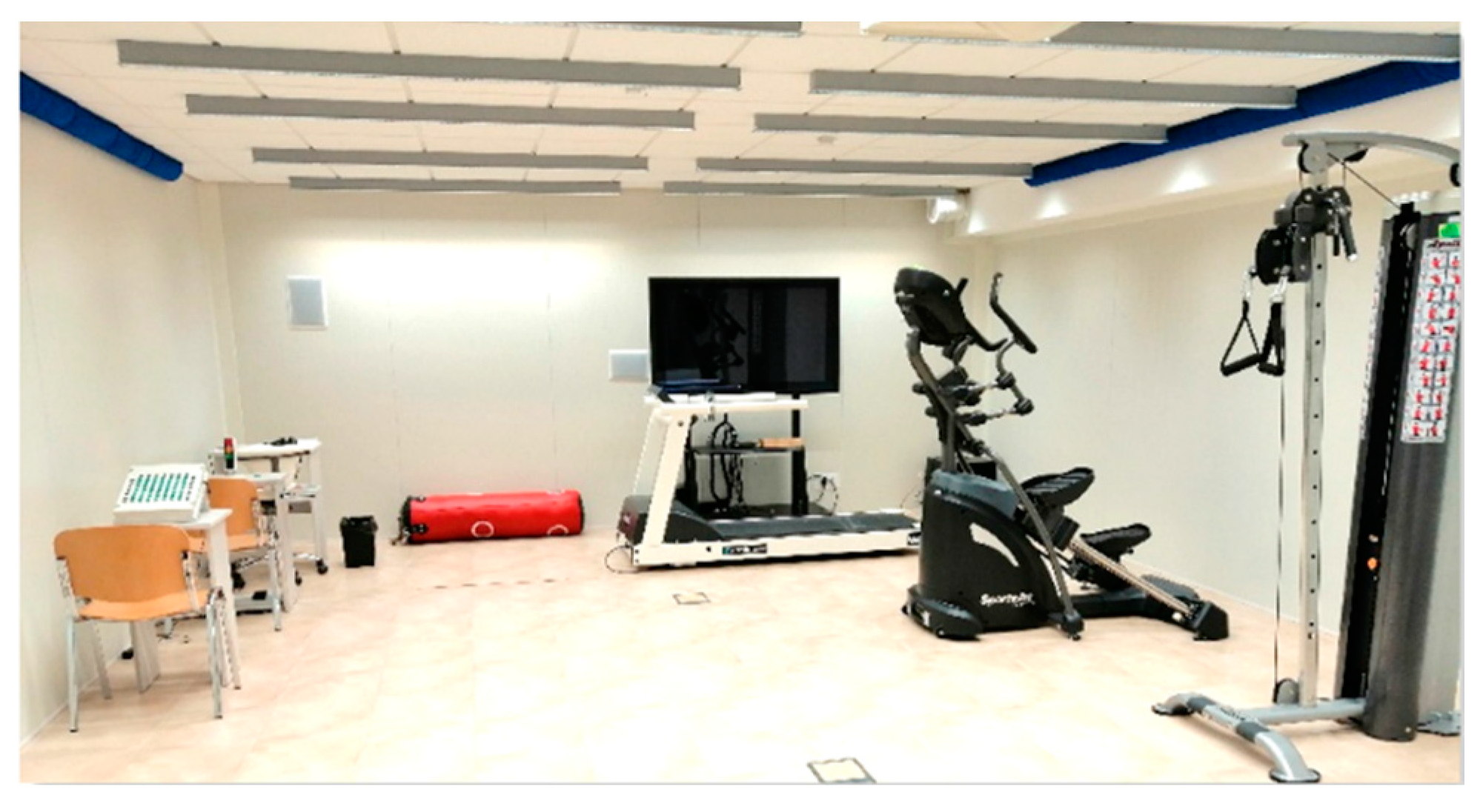

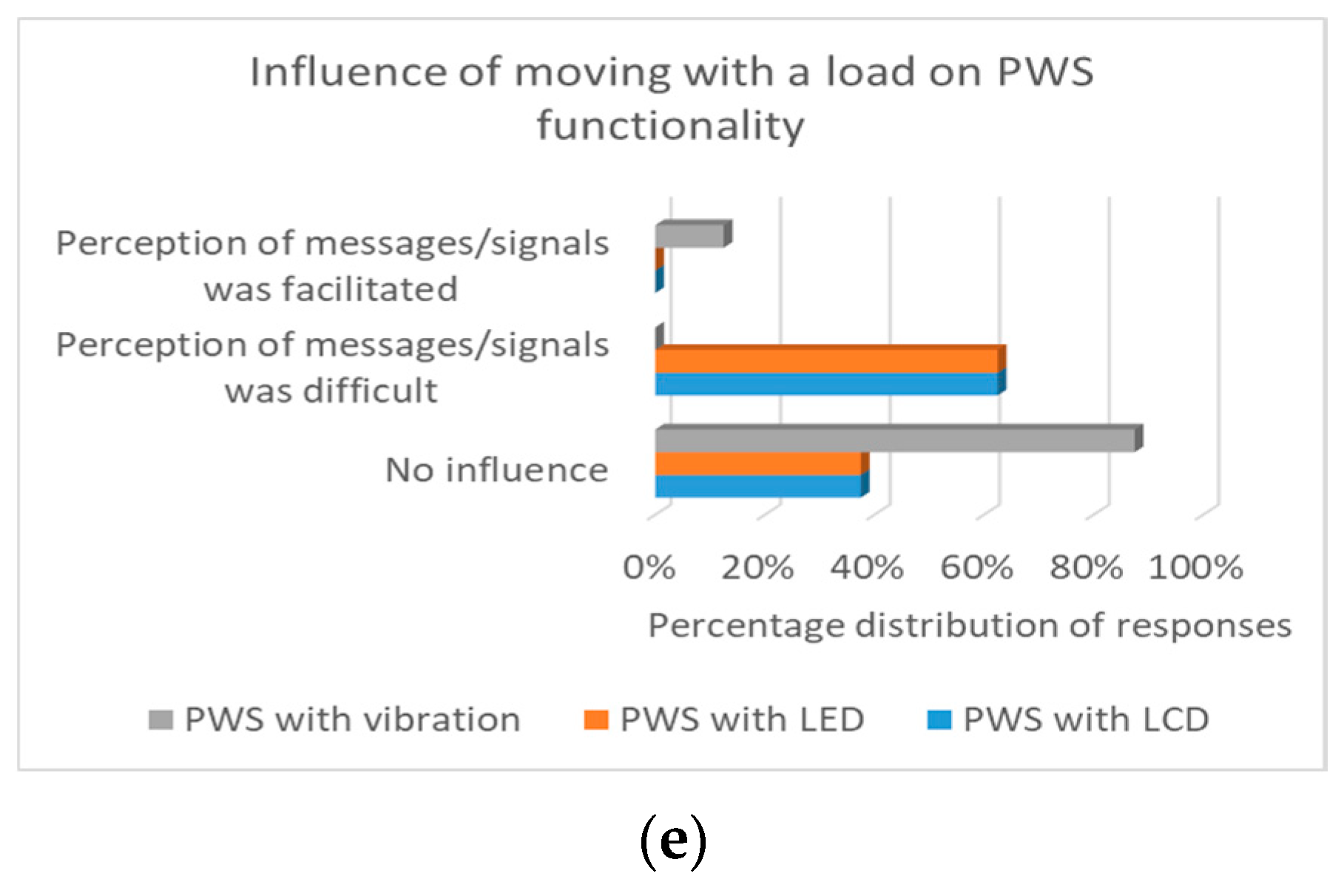
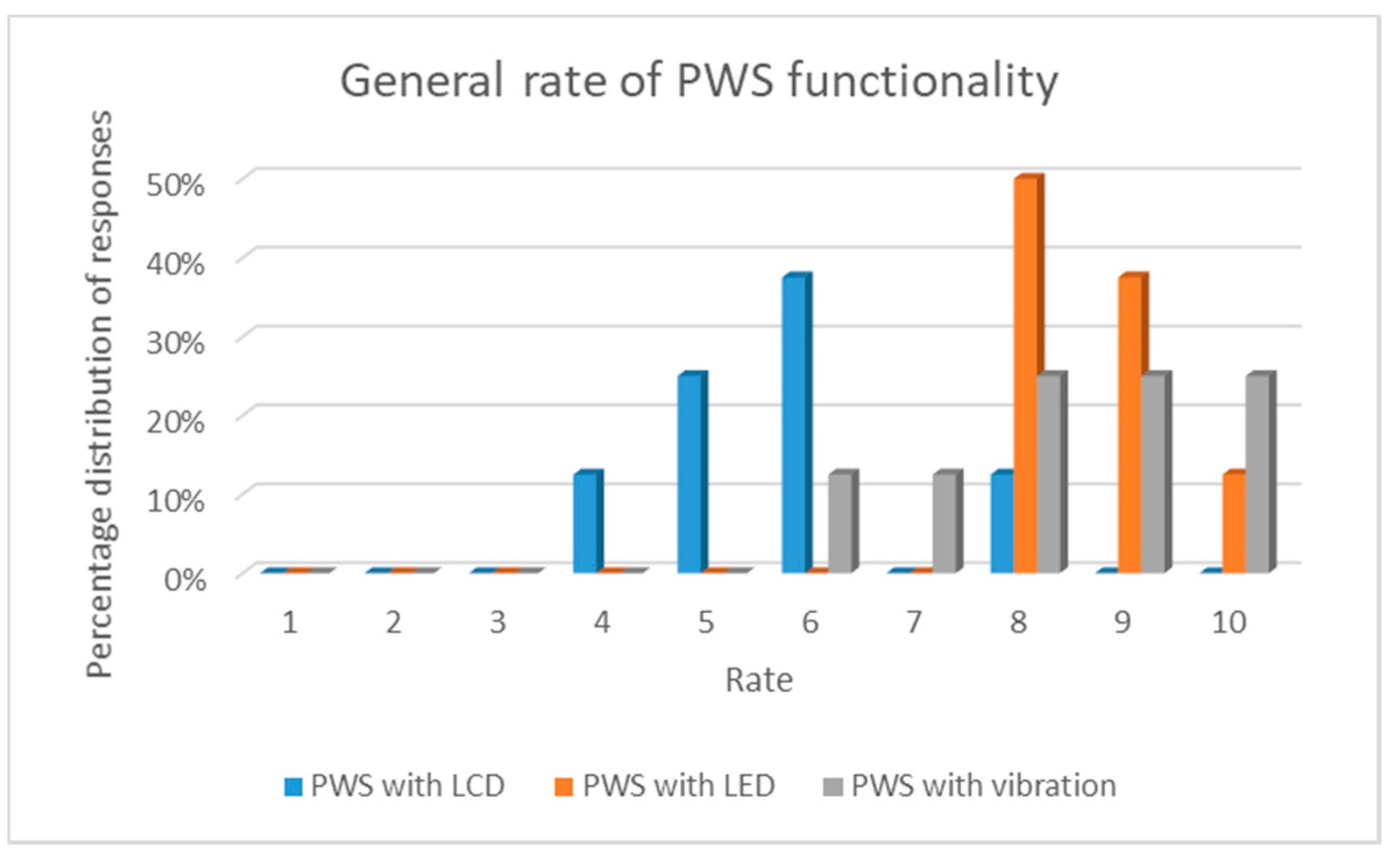
| Description of PWS | A View of PWS |
|---|---|
| Personal warning system with LCD display: PWS consists of a board with a 2.4 “LCD display, which also serves as a programmable processor (microcontroller), Wi-Fi communication module and LCD display. This system is powered by a USB connector using a powerbank. As a result of consultations with firefighters, the PWS allows the transmission of three messages: no danger (“OK”), temperature alarm, chemical alarm. As specified in the technical documentation provided by its manufacturer the LCD module can operate in the ambient temperature range −10 to +60 °C (with possible periodic exposures to maximum temperature rating of −20 to +70 °C). | 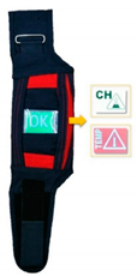 |
| Personal warning system with LED diodes: This system consists of two flexible lines of RGB LEDs (6 pcs in each line), a microcontroller and a LiPo battery. It allows to adjust the light color (RGB model), brightness and frequency of light pulses transmitted by the diodes by specifying the expected high state time (diode on) and low state time (diode off). As specified in the technical documentation provided by its manufacturer the WS2812 diode junction can operate in the ambient temperature range −25 to +80 °C |  |
| Personal warning system with vibrating element: PWS is built of a system of 5 vibration micro motors connected in parallel, a microcontroller and a LiPo accumulator. It provides the ability to adjust in terms of vibration (triangular or rectangular) and the intensity of vibration as a function of time. As specified in the technical documentation provided by its manufacturer the vibration micro motors can operate in the ambient temperature range −10 to +60 °C | 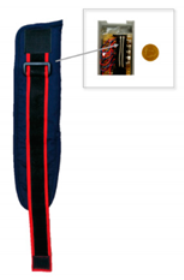 |
| No | Station | Characteristics of Physical Activity | Photo |
|---|---|---|---|
| 1 | Getting to the place of incident | Treadmill walking at 5 km/h for 10 min |  |
| 2 | Walking up the stairs | Exercise on a climbing trainer at a speed of approx. 40 str/min, stride length 30–50 cm, time 3 min |  |
| 3 | Crashing an obstacle | Exercise on the upper lift with a load 18 kg, 3 sets of 10 repetitions for 3 min | 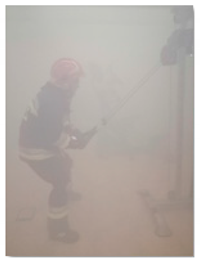 |
| 4 | Reaching the injured | Moving on all fours, a total distance of 15 m in 3 series of 5 m for 3 min |  |
| 5 | Transport of injured | Moving with a load 21.5 kg, a total distance of 15 m, in 3 series of 5 m for 3 min | 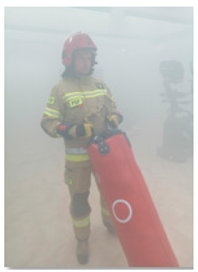 |
| Signal | Time, min:s | Light Intensity, lux | Light Temperature, K | Smoke Generator Efficiency, % |
|---|---|---|---|---|
| LCD—T | 1:15 | 1450 (to 5. min) | 6500 (to 5. min) | 15 (to 3. min) |
| Noise 1 | 2:00 | |||
| Vibration | 3:30 | |||
| LED | 4:20 | |||
| LCD—CH | 6:30 | 10 (from 5. min) | 2700 (from 5. min) | 0 (from 3. min) |
| LED | 7:20 | |||
| Vibration | 8:50 | |||
| Noise 2 | 9:30 | |||
| LCD—T | 0:30 | 10 | 2700 | 0 |
| LED | 1:15 | |||
| Vibration | 2:00 | |||
| LCD—CH | 2:45 | |||
| LED | 0:30 | 10 | 2700 | 0 |
| LCD—CH | 1:15 | 15 (from 1. min) | ||
| LCD—T | 2:00 | 0 | ||
| Vibration | 2:45 | |||
| LCD—CH | 0:30 | 10 | 2700 | 0 |
| Vibration | 1:15 | |||
| LED | 2:00 | |||
| LCD—T | 2:45 | |||
| LED | 0:30 | 10 | 2700 | 0 |
| LCD—CH | 1:15 | |||
| Vibration | 2:00 | |||
| LCD—T | 2:45 |
| Station | Signal | Voice Response Time, s | Missed Signals, % |
|---|---|---|---|
| Station 1 | LCD-T | 12.00 ± 4.24 | 75.0 |
| Vibration | 7.17 ± 3.87 | 0.0 | |
| LED | 3.33 ± 1.86 | 0.0 | |
| LCD-CH | 12.00 ± 9.64 | 62.5 | |
| LED | 3.38 ± 1.30 | 0.0 | |
| Vibration | 6.75 ± 4.77 | 0.0 | |
| Station 2 | LCD-T | 8.25 ± 4.57 | 50.0 |
| LED | 2.50 ± 0.93 | 0.0 | |
| Vibration | 6.13 ± 2.95 | 0.0 | |
| LCD-CH | 5.75 ± 2.87 | 50.0 | |
| Station 3 | LED | 2.50 ± 1.20 | 0.0 |
| LCD-CH | 7.71 ± 3.40 | 12.5 | |
| LCD-T | 6.71 ± 7.30 | 12.5 | |
| Vibration | 5.13 ± 3.40 | 0.0 | |
| Station 4 | LCD-CH | 8.60 ± 1.67 | 37.5 |
| Vibration | 5.63 ± 5.01 | 0.0 | |
| LED | 1.63 ± 0.74 | 0.0 | |
| LCD-T | 5.33 ± 2.80 | 25.0 | |
| Station 5 | LED | 2.13 ± 0.83 | 0.0 |
| LCD-CH | 6.67 ± 2.25 | 12.5 | |
| Vibration | 5.50 ± 4.57 | 0.0 | |
| LCD-T | 6.14 ± 2.04 | 12.5 | |
| Mean values from all stations | LCD-T | 7.69 ± 2.64 | 35.0 |
| LCD-CH | 8.15 ± 2.41 | 35.0 | |
| LED | 2.58 ± 0.68 | 0.0 | |
| Vibration | 5.83 ± 0.63 | 0.0 |
| TT, s | LCD-T | LCD-CH | LED | Vibration |
|---|---|---|---|---|
| Mean value | 2.58 | 2.54 | <1 s | 1.06 |
| SD | 0.15 | 0.07 | - | 0.12 |
Publisher’s Note: MDPI stays neutral with regard to jurisdictional claims in published maps and institutional affiliations. |
© 2021 by the authors. Licensee MDPI, Basel, Switzerland. This article is an open access article distributed under the terms and conditions of the Creative Commons Attribution (CC BY) license (http://creativecommons.org/licenses/by/4.0/).
Share and Cite
Dąbrowska, A.; Bartkowiak, G.; Kotas, R. Evaluation of Functionality of Warning System in Smart Protective Clothing for Firefighters. Sensors 2021, 21, 1767. https://doi.org/10.3390/s21051767
Dąbrowska A, Bartkowiak G, Kotas R. Evaluation of Functionality of Warning System in Smart Protective Clothing for Firefighters. Sensors. 2021; 21(5):1767. https://doi.org/10.3390/s21051767
Chicago/Turabian StyleDąbrowska, Anna, Grażyna Bartkowiak, and Rafał Kotas. 2021. "Evaluation of Functionality of Warning System in Smart Protective Clothing for Firefighters" Sensors 21, no. 5: 1767. https://doi.org/10.3390/s21051767
APA StyleDąbrowska, A., Bartkowiak, G., & Kotas, R. (2021). Evaluation of Functionality of Warning System in Smart Protective Clothing for Firefighters. Sensors, 21(5), 1767. https://doi.org/10.3390/s21051767








